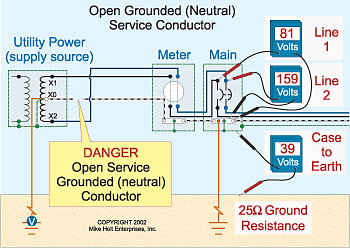Tersh,
Referring to the middle schematic diagram-- your theory holds. However, in the real world-- electronics/electricity doesn't behave exactly what you have envisioned.
The instance you cut the wire that is grounded (the one indicated with an “X”) with color blue-- the current passing through the inductor that is being compared with the top (brown) wire will see a change in current. During this split-second exigency, power will also be lost.
With its blue wire losing its connection to the lower inductor -- which WAS connected to ground—the RCD will not have the chance to compare this current that it was seeing before the wire was severed.
For this RCD to function without false alarm, it needs a wee time delay to ignore tripping caused by transient disturbances. . . otherwise you will be inundated with nuisance shutdowns. It needs to discriminate between the good and the bad signal.
Now, you can argue that the (MEN) multiple earth neutral will provide the continuity of power through the multiple ground connection, and (hopefully) enable the RCD to function and open the contacts.
The problem with this is, earth is an unreliable conductor whose resistance could vary depending on the moisture content.
And besides, it is an unorthodox even insane- not an acceptable and totally unsound engineering practice.
If you had driven these rods in the infiniteness of moist ground like a rice field in the Philippines, you will probably see a uniform impedance, but it will still not pass muster in a sensible engineering practice.
Now, the third diagram with the REVERSED HOT to NEUTRAL scenario is even worst.
If you reverse the BLUE and BROWN as indicated in your drawing -- you would end up connecting the hot brown wire (and while at the same time) keeping the MEN connected the way they are-- you'd be creating a short circuit.
Try tracing it systematically and you'll see what I'm talking about.
Note:
I'm not endorsing anything that could compromise safety. Hiring a multi- licensed electrician will not absolve you from any consequences that may arise should you go ahead with what you think would achieve your goal.
Don't call
Jacoby and Myers telling them that Myspark, told you how it should be done. I'm just answering your question.
Mabuhay! 








